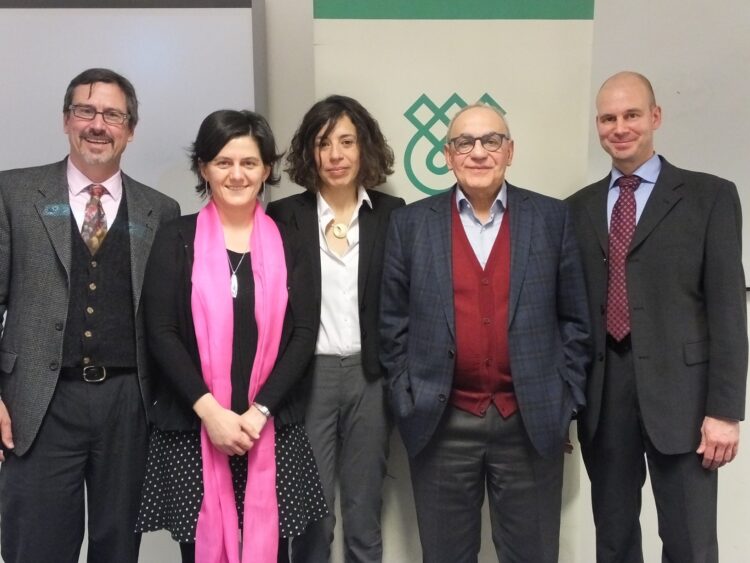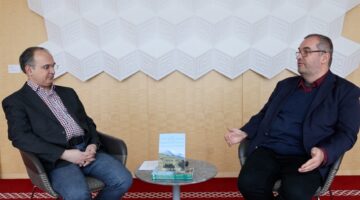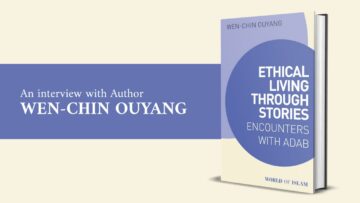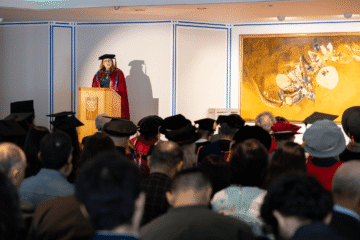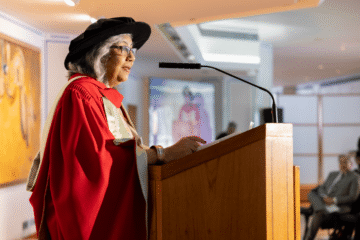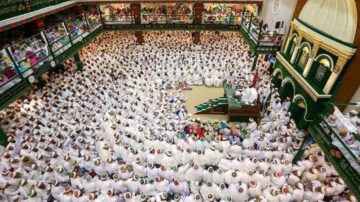This short video introduces one of the oldest manuscripts of the Qur’anMuslims believe that the Holy Qur’an contains divine revelations to the Prophet Muhammed received in Mecca and Medina over a period of 23 years in the early 7th century CE. More, the Sana‘a Palimpsest, dating back to the 1st-2nd century AH / 7th century CE.
The manuscript was discovered in Yemen, during the 1972 restoration of the Great Mosque of Sana’a. The manuscript has 38 leaves on which two superimposed Qur’anic texts are written. The lower text dates back to the 7th century CE, and was subsequently erased for a second text of the Qur’an to be written on it around the 8th century CE. The two layers were photographically separated by a French–Italian scientific mission in 2007 enabling a study showing that both the Qur’anic texts are fragmentary and present aspects of work in progress, with incomplete decorative elements in the upper text and in the lower text an early reading instruction being rendered visible.
In 2017, IIS published The Sana‘a Palimpsest: The Transmission of the Qur’an in the first centuries AH presenting a new annotated edition of the two layers of the Sana‘a Palimpsest (Manuscript 0127-1 from Dar al-Makhtutat, Sana‘a). The author, Dr Asma Hilali, provides a comprehensive introduction to the Sana‘a Palimpsest, with systematic reference to previous studies and partial editions of the same manuscript. Based on her own decade-long study of the Sana‘a Palimpsest, she presents a new hypothesis regarding the context of transmission for the texts in both layers of the manuscript.
At the roundtable Approaching Religious Texts in Early Islam the participating scholars critically acclaimed Dr Hilali’s work on the Sana’a Palimpsest, and shared views on how early Qur’anic manuscripts, such as the Sana’a Palimpsest, help to further the academic research on the early periods of Islam
Transcription created by Professor Elizabeth Urban
Dr Omar Alí-de-Unzaga: The study of manuscripts of the Qur’an, I would say, is at an early stage. It’s in its infancy. There is a boom of studies on it, but there is so much material out there. We don’t even know how many manuscripts are there, lying around. We know that there are libraries with hundreds, perhaps thousands of manuscripts, many of them of the Quran, which have not been even catalogued.
One of these discoveries was made in the 1970s in the Great Mosque of Sana’a in the Yemen, where a group of builders were fixing a ceiling, and the ceiling collapsed, and they found a variety of materials, written materials, which they took to the authorities. Now part of this collection was one of these pieces that we call “palimpsests.” That is a piece of parchment, a piece of animal skin, which has been prepared for writing, and has been written on with one text, and then later on, for whatever reason, has been erased and written on top—so we’ve got two layers. Now, we call one of these palimpsests the Sana’a Palimpsest, and it’s the object of our latest book in the Qur’anic Studies Series.
1. What is the Sana’a Palimpsest?
Dr Asma Hilali: The Sana’a Palimpsest is a manuscript made of parchment. This parchment has been palimpsested—that means, has been washed (very probably, rather than scratched), and another text has been written upon the erased script. So, in the case of the Sana’a palimpsest, both layers of text are Qur’an.
Dr Alí-de-Unzaga: The difference in time between the lower layer and the upper layer, both of them being Qur’anic, is very short. Perhaps 50 years, perhaps 100 years, but not more than that.
Dr Hilali: The book [I wrote on this topic] consists on the edition of both layers of texts, the lower text and the upper text. Both are passages of the Qur’an, and they are dated by the experts to the 7th century for the lower text and the 8th century for the upper text. The main objective of this work is to understand for which use each layer of text has been written. Why people in the 7th century wrote the Qur’an fragments and then they erased them, and they wrote upon the erasure another Qur’an. So, the question is: Why, and when, and how they did it.
Dr Aziz al-Azmeh: These more recent discoveries in the study of Qur’anic manuscripts, especially the very very early ones, the very very early ones, they have…they contain a number of textual layers and indicators to the context out of which they arose, which would actually help us reconstruct, historically, the process of Qur’anic composition and redaction over time in a particular historical setting. In this way, they would supplement material that we know from later literary sources, and one very interesting thing, given the atmosphere of historiographic skepticism, is that some of this manuscript material…these material sources actually then confirm quite a lot of what occurs in later literary sources as well. And this goes really against a prevalent mode of skepticism toward Arabic sources in general.
2. How do we know that these manuscripts are authentic?
Dr Alí-de-Unzaga: Well, we can say that nowadays there are different techniques helping us study these objects. One of them being ultralight, ultraviolet lighting and photography. Photoshop has given a lot. The other technique that has also been used to date these manuscripts, these objects, is radiocarbon 14. Now for this you need to cut a little corner of the object, which in itself is slightly problematic, if you want, and put it under the test. Now, radiocarbon 14 does not give you an exact year, it gives you a range of dates, but nevertheless the tests that have been carried out on the Sana’a Palimpsest throw a very, very early date. So, we are talking about the first generations of Muslims who have produced these texts.
3. How and when did the French-Italian mission take images of the Sana’a Palimpsest?
Dr Alba Fedeli: The French-Italian mission for the imaging of the Sana’a Palimpsest was in October 2007, and it you know it took just one week for imaging the Palimpsest. What is interesting is to underline the fact that for arriving to that week, to be able to do the imaging, we needed 5 years of establishing contacts with the Yemeni authorities and scholars in order to have permission, because it’s not just a matter of imaging, but it’s a matter of having permission for making the images. The other aspect of the French-Italian project is the fact that, for the first time, they used a special imaging, so they applied ultraviolet lights in order to enhance the lower text, and they tried to make it more visible or legible.
4. Was the lower text easily legible or did you have to use some techniques?
Dr Hilali: The method consists mainly of reconstructing the lower text as far as it’s possible, because this erased script will remain palimpsested—we cannot reconstruct the whole text. And after they did the reconstruction, the second objective is to edit the text, to edit the text with filling the missing parts. My book consists of an edition of the lower text and of the upper text, and analysis of the particular features of the manuscript that show the reasons behind writing these passages of the Quran.
Dr Alí-de-Unzaga: This discovery, together with other discoveries such as other manuscripts in Birmingham, a discovery some decades ago in Cambridge, and other places, have called the attention of the scholars. There are a number of scholars who are actually studying the material aspect of the objects, what we call codicology, and there are others who are devoting their efforts to the study of the text itself. So Asma Hilali, what she’s done, she has done an edition of the text. The book itself does not reproduce the images of the palimpsests, but it provides the transcription of the text, which is an incredible difficult exercise.
Dr Hilali: I published this work in order to show that the Qur’an text is not an immaculate object, it has a history, it has been used by people, the Qur’an has not been always a book, but also fragments written, collected, erased, annotated, explained by students, teachers, for private rather than for public use.
Dr Fedeli: The Sana’a Palimpsest has many interesting features, like for example, the different order of the Surahs. So, for example Surah 9 is followed by Surah 19, and this is quite a remarkable element in the Sana’a Palimpsest, with all the other elements.
Dr Stephen Burge: The book on the Sana’a Palimpsest really highlights the fluidity between the oral and the written, which really influences the way I understand the transmission of hadith but also the transmission of the Qur’an itself, and the way in which religious texts were received in the very earliest period of Islam.
Dr Alí-de-Unzaga: The study of these manuscripts may shed light on how people formed reading circles, how people were taught, how people memorized. Of course, there is an element of making hypotheses and also speculation at times, but these are evidence. The Muslim tradition says that it was, the Quran was revealed to the Prophet Muhammad, and then it was written down by various companions in various forms. Some accounts say that some companions may have compiled whole copies of the Qur’an, and that it was Caliph Uthman who then created an officially sanctioned copy, if you want. And so, what the study of manuscripts does, is that it provides material evidence in support or against some of these theories.
Dr Andreas Görke: I’m coming from the side of the Islamic tradition, so the narrative tradition which is rather late, and while it’s possible to get an idea of the debates were in the first, beginning of the second century, this is all very speculative to some degree, and not rooted in something that we can actually grasp. So, with texts like the Sana’a Palimpsest, we do have texts which actually relate to that time, that come from that time, and that do confirm quite some ideas of what we have from the tradition, so the large variety of different versions of the Qur’an, variants of the Qur’an, while at the same time maintaining a more or less similar text, that is something that the Palimpsest actually shows us, which otherwise we can only deduce from the tradition.
Dr Jonathan Brockopp: For me, it’s really important to think of these manuscripts as products of a social milieu, so they’re not just the holders of a text, they don’t merely possess the language of the Qur’an, it’s also something that was produced by people for other people, and so it’s the communities of readers of the Quran, the communities of scholars, who produced and used these manuscripts that I think is one of the most important things for us to understand.
What is the focus of the Qur’anic research at the IIS?
Dr Alí-de-Unzaga: The Quranic Studies Series that the Institute of Ismaili Studies publishes, has produced 17 books, and this is the 17th volume. Until now, we had focused mostly on the history of the interpretation of the Qur’an, in both in classical times and in modern times, and also as regional approaches. We have a volume on approaches to the Qur’an in Indonesia, we have a forthcoming volume on approaches to the Qur’an in Iran, [and one] in Africa. So, we have been focusing on the reception side of the Qur’an. With the book, with the publication of the Sana’a Palimpsest edition, what we do is we focus directly on the text of the Qur’an, and on the very early history of the transmission of the Qur’an in the early circles.
We thought that it would be important in the Qur’anic Studies Series because our series deals with the variety of interpretations, the diversity of interpretations and approaches to the Qur’an. So, in focusing on one of the very earliest manuscripts of the Qur’an that we know, we thought that this would also allow the readership to look at the variety of approaches that Muslims and others have had with regard to the text itself and not necessarily with its interpretation. What this book gives us is, it opens up a number of avenues. It shows that the history of the compilation of the Qur’an is very complex, that we cannot rely on one monolithic account, but we have to consider various different hypotheses. And I think this is what this scholarship does, it opens up various hypotheses as to how this text may have been transmitted.

